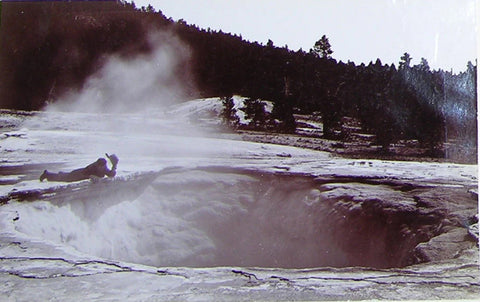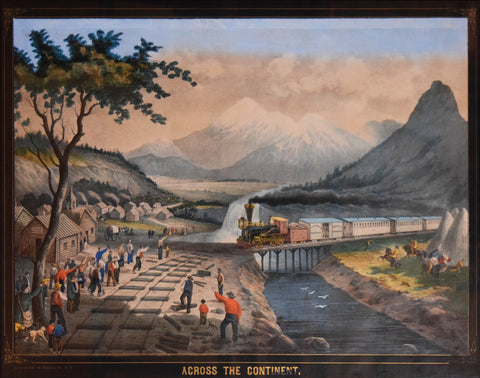
Frank Jay Haynes (1853-1921), Crater of Giantess Geyser
Frank Jay Haynes (1853-1921)
Crater of Giantess Geyser
YELLOWSTONE NATIONAL PARK
Number 32 penciled lower left-hand corner
Fine albumen print, mounted on archival matte
Photograph size: 5 x 8 in.
Matte board size: 11 x14 in.
Provenance: from the library of William E. Hofman, his sale Christie's 3rd December, 2010, lot 343
A magnificent view of the large crater of the celebrated Giantess geyser in Yellowstone National Park with someone lying at the edge and looking into the abyss, by official Yellowstone Park photographer Frank Jay Haynes. In 1870 the Washburn-Langford-Doane Expedition explored the Upper Geyser Basin and observed geysers erupting, they named seven geysers in the basin, including this Giantess: "One of the most remarkable geysers was "The Giantess," for yards around the ground rose gradually to its crater, but immediately about it was no formation rising above the surface, as was the case with all the other geysers which we saw in active operation. When quiet, it was a clear, beautiful pool, caught in a subsilica urn, or vase, with a hollow, bottomless stem, through which the steam came bubbling, just like the effervescence of champagne from the bottom of a long, hollow-necked glass. The mouth of the vase, represented by the surface, was twenty feet by thirty; and the neck, fifty feet below, was fifteen feet by ten. The water, at times, retired to the level of the neck, or vent, and at other times rose nearly to the surface. When in action, "The Giantess" became a fountain with five jets, shooting the spray to a height of two hundred feet. At the surface the largest jet was about two feet in diameter, and it kept in solid column for more than a hundred and fifty feet before breaking into drops and spray. It burst forth just before sunset, and the last rays of light gave prismatic tints to the glistening drops, when, having reached their utmost altitude, they trembled at their coming fall. The clouds of steam, which in this, as in all other instances, accompanied the boiling water, became a golden fleece lit up by wreaths of rainbows. Though inferior to "The Giant" in immensity of volume, and perhaps in grandeur, "the Giantess" was by far the most beautiful sight we saw in the geyser basin" (Walter Trumbull "The Washburn Yellowstone Expedition". Overland Monthly 6 (5-6)).
Yellowstone, was the world's first national park, and "is situated mainly in Wyoming and extends into Montana and Idaho. It was established in 1872 by Congress, primarily because of its geysers, but also because of its remarkable assemblage of wildlife and unusual natural features. The "national park idea" pioneered at Yellowstone eventually spread worldwide. In the United States, Mackinac Island National Park (now a Michigan state park) was established in 1875 and Sequoia and Yosemite National Parks in 1890. (Yosemite had been a California state park since 1864.) Yellowstone remains the "mother park" in the U.S. national park system, which by the 1990s included 376 sites.
The celebrated photographer Haynes was first hired as the official photographer of the Northern Pacific Railroad and "given his own travelling studio in a converted rail car, Haynesproduced numerous famous images of the railroad's construction projects and of sites along its route. He held that position for nearly three decades. He also was appointed in 1884 as Yellowston's official photographer and sold materials from a store in the park itself. He retired in 1916. His images of Yellowstone are among his more important and dramatic imagery" (see Dorothy Sloan, Western Americana,10/18/2006, lot 254).
"Boasting about three-quarters of the world's geysers (of which Old Faithful is the most famous) and over half of the thermal features, it also has one of the globe's most spectacular canyons, one of North America's most celebrated waterfalls, and more than 225 permanent waterfalls higher than fifteen feet. It has the premier wildlife sanctuary (and the top three trout-fishing streams) in the continental United States. Unmatched in the variety and number of its megafauna, the park shelters the world's largest concentration of elk and is one of the last remaining strongholds of the grizzly bear in the coterminous states. It is the only site in the United States (and one of only two in the world) where a wild bison herd has survived continuously since ancient times. At the center of the largest relatively intact ecosystem in the North Temperate Zone, its hundreds of lakes, creeks, mountains, and valleys survive in essentially pristine condition. As in all major parks, Yellowstone's administrators debate the appropriate forms of intervention to protect this delicate ecosystem and strive to balance the competing claims of public access and wilderness preservation" (see Aubrey L. Haines, The Yellowstone Story, 1996; James Pritchard, Preserving Yellowstone's Natural Conditions: Science and the Perception of Nature, 1999).
We Also Recommend




![Arthur Burdett Frost (1851-1928), “5” [A Western Scene]](http://aradergalleries.com/cdn/shop/products/Unititled_man_with_horses_and_top_hats_large.jpg?v=1491240574)
